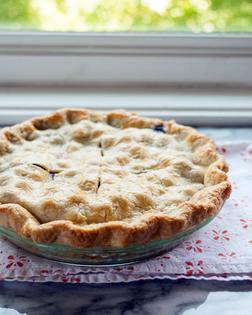THE KITCHN: Fear not the homemade pie crust!
I am very worried, friends -- worried that the fear of pie crusts may be keeping a great many of you from making your own pies at home. Is this true? Does this sound like you? Do debates over butter vs. lard or tender vs. flaky make you want to run and hide?
Well, take a deep breath and grab your notebook -- today we're going to go over how to make a pie from start to finish, one step at a time.
Here's your first lesson: Homemade pies do not have to be perfect. Really. This is a hard lesson to learn because we want that perfectly crimped and beautifully burnished pie crust so badly! I completely understand. But when your pie crust rips in half while you're transferring it to the pan or when you don't have quite enough dough to make those tall, crimped edges -- it's OK. Remind yourself that at the end of the day you still have pie, and that's all that matters.
Next lesson: The more you make pies, the better you'll be. Making pie crust is a lot like riding a bike -- it takes a lot of practice before you can pull it off every time. That pie in the photo with this story? The one that looks so homey and pretty? I can honestly say that this is the first beautiful pie that I've ever made in my life. I was just as astounded as you when I pulled it out of the oven and saw that it hadn't shrunk, collapsed, burnt or otherwise become disfigured. I don't want to jinx myself by saying that I'm now a pie-making pro, but I really do feel that each pie I've made has been better than the last.
Here are a few more things to think about before you head into the recipe:
-- Butter vs. lard vs. mixed crusts
Pie crusts are made by working fat into flour -- when the fat melts during baking, it leaves behind layers of crispy, flaky crust. Yum. But just what fat you use in your pie is a matter of much debate -- one that really boils down to personal preference. All-butter pie crusts have a lovely, rich flavor, but because butter is brittle when cold and softens quickly, it can be difficult to work with. Lard and shortening are easier to work with and, arguably, make flakier crusts, but can leave your crust tasting a little bland. A good solution is to use a mix of both butter and lard or shortening. I leave it to you to decide what you like best.
-- Flaky vs. tender crusts
The flakiness of a crust is a result of both the fat you use and how much you work the fat into the flour before adding the water. Because of their higher melting temperature and its unique structure, lard and shortening make the flakiest crusts. But you can still make a very flaky crust using all butter (or a mix of butter and lard/shortening) by not over-incorporating the butter into the flour -- cut it into the flour just until you see pieces no larger than peas. Conversely, if you like a very tender crust, work the butter or lard into the flour until it resembles bread crumbs.
...continued







